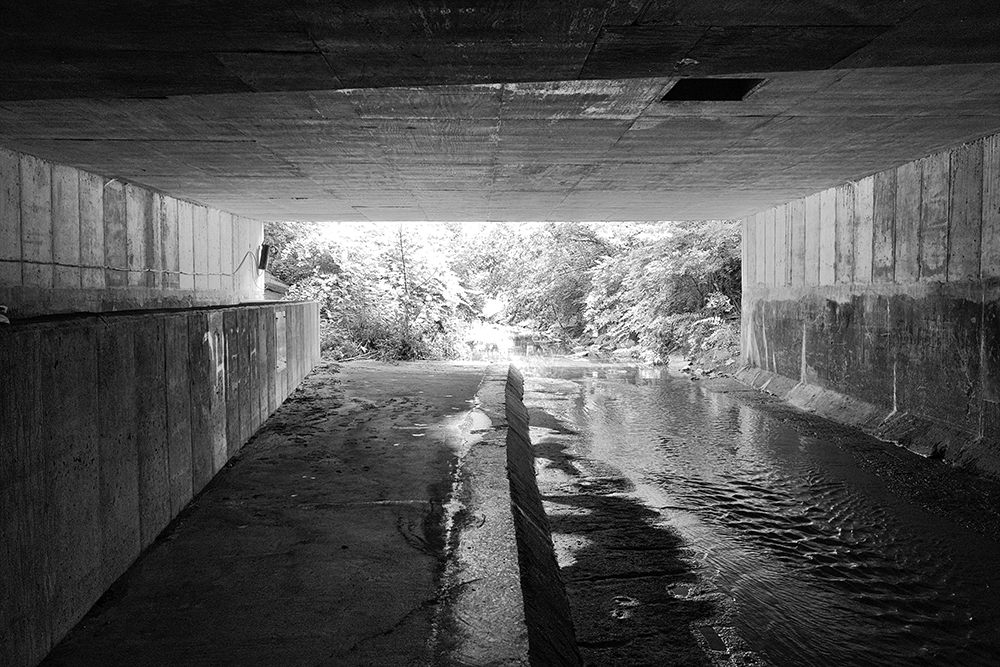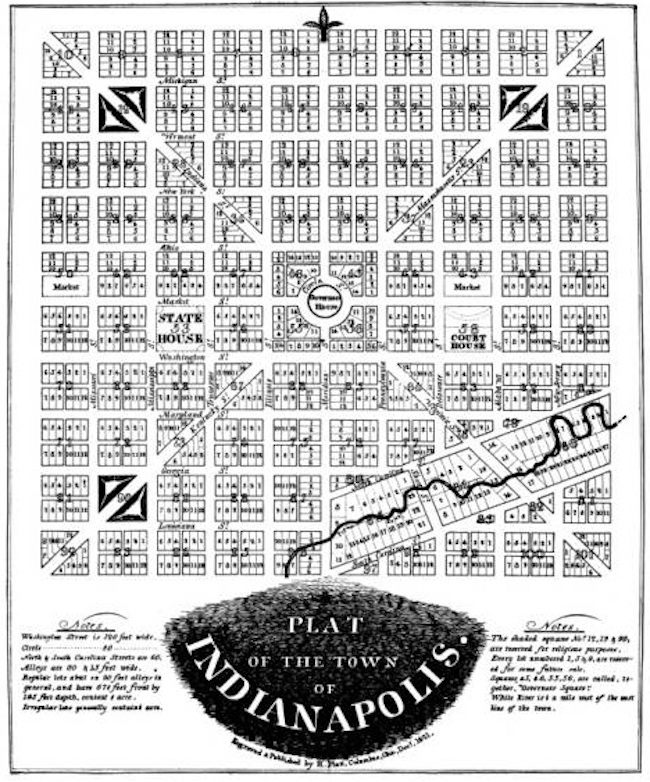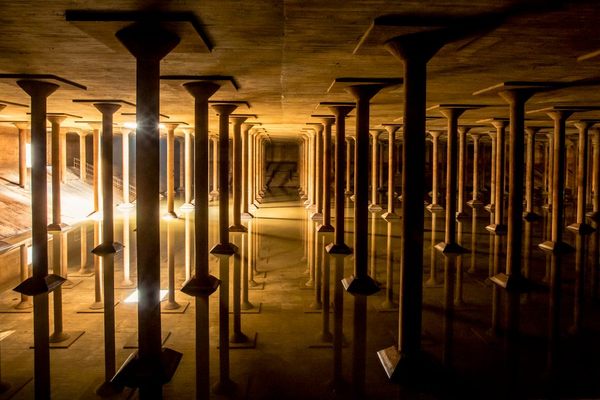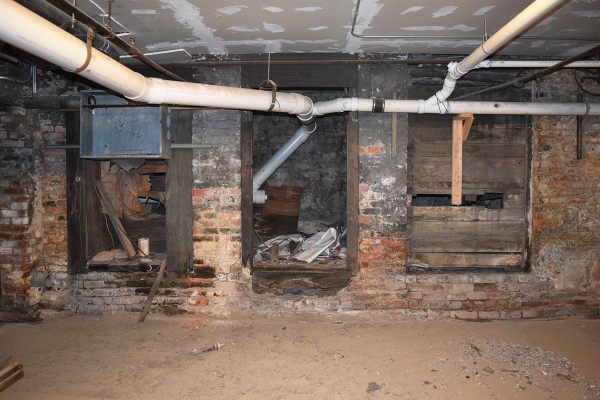You Can Follow a Hidden Stream Beneath Indianapolis—If You Know Where to Look
Pogue’s Run makes an appearance in the best-selling novel ‘Underground Airlines.’

Looking out from the Pogue’s Run tunnel. (Photo: Stuart Hyatt)
There’s a moment in Underground Airlines, Ben Winters’ novel of an alternate history in which slavery in America was never abolished, when the protagonist has no choice but to go physically underground. An escaped slave who becomes a slave catcher after his own capture, Victor is hunting another, and his search leads him to a creek running under Indianapolis. It’s called Pogue’s Run, he says, and it was buried because it didn’t fit into the design of the city.
Unlike much of the carefully imagined world of the novel, Pogue’s Run is real. It runs under Indianapolis for two-and-a-half miles, and it’s possible to walk from one end to another. It helps to have a guide who knows the stream; Winters’ was Stuart Hyatt, a local musician, who, he writes, was responsible for “inducting me into its secrets.”
All underground streams have a mystery about them, but Pogue’s Run has a more ghostly history than most. Its story begins with one of Indianapolis’ first white settlers, whose disappearance has never been solved, and a Scottish-born city planner with a tidy vision.

Pogue’s Run, in an 1871 painting. (Image: Jacob Cox/Public domain)
George Pogue arrived on the banks of Pogue’s Run in 1819, with a wife, seven children, and a herd of horses. Back then, the stream was called Perkins’ Run, after another white settler who’d lived there briefly. One morning, after some of his horses had disappeared, Pogue took off after a Native American man who’d come by the farm: Pogue thought he might know who had taken the horses.
That was the last time anyone reported seeing Pogue; though settlers sent out search parties, they never found his body. He had disappeared, just two years after he moved to the area. His name stayed, though; that stream was now called Pogue’s Run.
Not far from Pogue’s cabin was the site that Indiana’s newly organized General Assembly had picked, in 1820, for the capital of the four-year-old state. The assembly hired Alexander Ralston, who had worked with Washington. D.C.’s famed planner Pierre L’Enfant, to draw up a scheme for the new city. Ralston’s elegant design echoed D.C’s: Indianapolis would be a square grid, a mile on each side, with a circular plaza in the center and four wide, stately boulevards radiating out towards each of the square’s corners.
Except—in the southeast corner of the city, the gridded blocks tilted, askew. There was a black line snaking through the plan, throwing the grid off kilter. That was Pogue’s Run, ruining the city’s planned symmetry.

Ralston’s original plan for Indianapolis. (Image: Alexander Ralston/Public domain)
In the 19th century, as Indianapolis grew into and out of the original Mile Square plan, Pogue’s Run troubled the city. In the rainy seasons, it would overflow its banks, flooding streets and damaging property. And as sewers dumped their contents into the water, the run became one of the city’s most polluted waterways.
Eventually, city planners decided they’d had enough. By 1905, they were planning a “straightjacket” for the stream, to keep its water contained, and in 1915, they trapped the run underground.
On the newly open space, the city built its train station, its football stadium, and its highways. Like George Pogue, Pogue’s Run disappeared, and after a few decades, no one thought much about the creek running underneath downtown Indianapolis.

Inside the tunnel. (Photo: Stuart Hyatt)
Outside downtown, though, on the other side of the highway, Pogue’s Run still flowed above ground. As a kid, Stuart Hyatt used to creek-stomp in the shallow water when he visited his grandmother. It’s a substantial bit of water—not a cute little babbling brook but a wide brown road of water cutting through the land.
Hyatt is a musician and artist, and a few years ago, he started recording audio out in the field and using it in his music. When he started working on Streamlines, an art project funded by the National Science Foundation, he thought of Pogue’s Run. He knew the water went underground, but how? And how long did it travel beneath the city?
At least once before, an artist had tried to draw attention to Pogue’s Run. In 2006, the artist Sean Derry mapped the stream’s original course on the city’s modern surface, using blue thermoplastic, which “would erode over time and change as a waterway naturally does,” he says. He imagined that over 15 or 20 years, the plastic would erode, until all that was left were cast-iron markers, planted at quarter-mile intervals, that would give people a sense of the run’s direction but also be dissociated from it. Parts of that line are still there, in some places just a drop of blue plastic.
Hyatt, though, was most interested in exploring the waterway as it ran under the city. He wanted to walk the whole length of the tunnel, but the idea scared him. The entrance is wide and intimidating. The walls are made from concrete, and just inside, the tunnel looks like a bunker built on an alien world, where a trusty blaster would come in handy. Walk some 200 yards deeper in, and the light is gone, ceding to total blackness.
FIELD WORKS: What is the City Hiding from TEAM Records on Vimeo.
When Hyatt brought Winters to Pogue’s Run, the author was in the formative stages of writing his book. “I needed a place where my hero could literally descend and find himself underground,” finding layers under layers, of both the case he was unraveling and his own identity, Winters says. Pogue’s Run felt like the right place.
Before he wrote the stream into his own book, though, Winters wrote about it for Hyatt’s album. On the last track, “Pogue Out Walking,” Winters’ short story is read in a long, slow cadence of a frontier tale. In it, George Pogue returns, centuries after his death, to the water named after him. He wanders down the river, noticing “the changed world,” gathering a crowd, until he reaches the tunnel mouth.
Then he disappears, for a second time. “Pogue walked right into the pipe, and everybody gasped, and then he was gone. They heard the footfalls getting softer as he was swallowed by darkness.”

The tunnel exit. (Photo: Stuart Hyatt)
Indianapolis, Winters found, was “not the kind of city that has a lot of big, built up myths.” The White River does not define the city in the way that the Charles River defines Boston, or the Potomac defines D.C., he says. But Pogue’s Run, in its obscurity and weirdness, has in the past decade or so become a piece of history that people want to preserve and hold onto. There’s now a Pogue’s Run Grocer, a co-operatively run store, and a Pogue’s Run porter, made by a local brewery.
Yet the story of the stream’s namesake is still murky; in the two centuries since George Pogue’s disappearance, no one has come up with a definitive ending. Every few decades, when unclaimed human bones turn up, there’s speculation that they might be Pogue’s. But most people presume he was killed by Native Americans, and that no one will ever know exactly where or how he died.
Hyatt walked the whole length of the tunnel, twice, with “an urban explorer type of dude who had been through it before,” he says. It’s not entirely clear which government agency has responsibility for it, or whether they were trespassing. Inside the pitch-black tunnel built more than a century ago, the water can be deep, or, depending on the rainfall, can slow to almost nothing, leaving dry concrete pathways on either side.
The ceiling is cracked, and side tunnels, made of brick, occasionally branch off the main route. It was very quiet inside, Hyatt says, except when surface sounds echoed through the tunnel. “A car going over a grate is like a giant, huge, reverberating thunder cloud. The train track is incredibly loud. It echoes forever, and it’s incredibly creepy.”
Cell phones don’t get service in the tunnel; the only way to get a sense of your location is to turn down one of those side tunnels, find a grate that cracks up into the city, stick a phone out of it, and take a picture. Then, all of a sudden, the tunnel ends, and the water pours out on the other side of town, into the White River.














Follow us on Twitter to get the latest on the world's hidden wonders.
Like us on Facebook to get the latest on the world's hidden wonders.
Follow us on Twitter Like us on Facebook